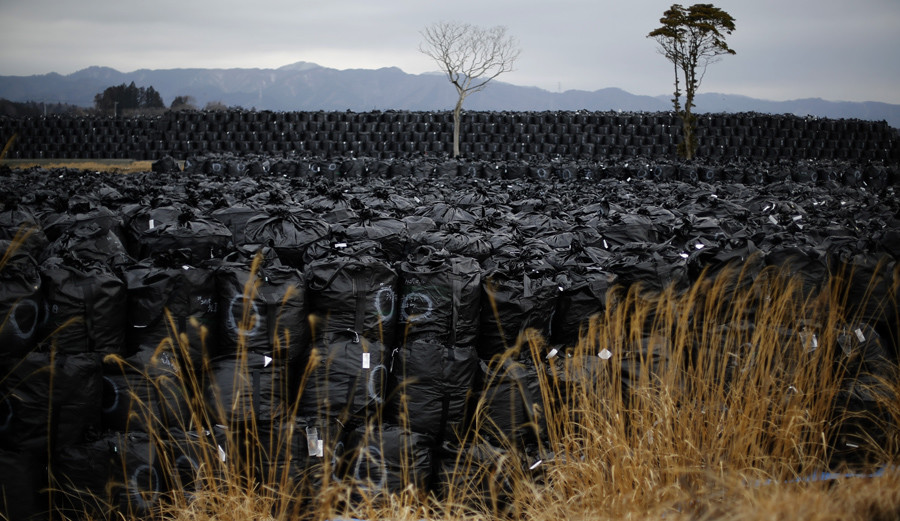600 Tons of Melted Radioactive Fukushima Fuel Still Not Found, Clean-Up Chief Reveals
ENVIRONMENT, 30 May 2016
Russia Today – TRANSCEND Media Service

A Tokyo Electric Power Co. (TEPCO) employee, wearing a protective suit and a mask, walks in front of the No. 1 reactor building at TEPCO’s tsunami-crippled Fukushima Daiichi nuclear power plant in Okuma town, Fukushima prefecture, Japan February 10, 2016. © Toru Hanai / Reuters
24 May 2016 – The Fukushima clean-up team remains in the dark about the exact locations of 600 tons of melted radioactive fuel from three devastated nuclear reactors, the chief of decommissioning told the ABC’s Foreign Correspondent program in an exclusive interview.
The company hopes to locate and start removing the missing fuel from 2021, the Tokyo Electric Power Company’s (TEPCO) chief of decommissioning at Fukushima, Naohiro Masuda, revealed.
The fuel extraction technology is yet to be elaborated upon, he added.
https://twitter.com/RT_com/status/708845065364328449/photo/1?ref_src=twsrc^tfw
Following the tsunami-caused 2011 meltdown at Fukushima Dai-ichi nuclear power plant uranium fuel of three power generating reactors gained critical temperature and burnt through the respective reactor pressure vessels, concentrating somewhere on the lower levels of the station currently filled with water.
The melted nuclear fuel from Reactor 1 poured out completely, estimated 30 to 50 percent of fuel from Reactor 2 and 3 remained in the active zone, Masuda said.
The official estimates that approximately “200 tons of [nuclear fuel] debris lies within each unit,” which makes in total about 600 tons of melted fuel mixed up with metal construction elements, concrete and whatever else was down there.
https://twitter.com/RT_com/status/711727345833549824?ref_src=twsrc^tfw
Five years after the Fukushima tragedy, the exact location of the highly radioactive “runaway” fuel remains mystery for TEPCO. The absolutely uncontrollable fission of the melted nuclear fuel assemblies continue somewhere under the remains of the station.
“It’s important to find it as soon as possible,” acknowledged Masuda, admitting that Japan does not yet possess the technology to extract the melted uranium fuel.
“Once we can find out the condition of the melted fuel and identify its location, I believe we can develop the necessary tools to retrieve it,” Masuda said.
https://twitter.com/RT_com/status/709008691404537856?ref_src=twsrc^tfw
TEPCO’s inability to locate the melted fuel could be explained by huge levels of radiation near the melted reactor shells. It is so high that even custom-built robots sent there to get information about the current state of affairs there get disabled by the tremendous radioactivity flux. Human presence in the area is understandably out of the question.
The company’s decommission plan for Fukushima nuclear power plant implies a 30-40 year period before the consequences of the meltdown are fully eliminated. Yet experts doubt the present state of technology is sufficient to deal with the unprecedented technical task.
https://twitter.com/RT_com/status/725868495762673666?ref_src=twsrc^tfw
“Nobody really knows where the fuel is at this point and this fuel is still very radioactive and will be for a long time,” the former head of the US Nuclear Regulatory Commission (NRC), Gregory Jaczko, told Foreign Correspondent.
“It may be possible that we’re never able to remove the fuel. You may just have to wind up leaving it there and somehow entomb it as it is,” said Jaczko, who headed the USNRC at the time of the Fukushima disaster.
Melted uranium fuel and tons and tons of highly radioactive water aren’t the only issues troubling TEPCO’s clean-up team at Fukushima. There are also some 10 million plastic bags full of contaminated soil concentrated in gigantic waste dumps scattered around the devastated nuclear facility.

Big black plastic bags containing radiated soil, leaves and debris from the decontamination operation are dumped at a temporary storage site in Tomioka town, Fukushima prefecture, near Tokyo Electric Power Co’s (TEPCO) tsunami-crippled Fukushima Daiichi nuclear power plant © Toru Hanai / Reuters
The Japanese prime minister at the time of the Fukushima disaster, Naoto Kan, told the ABC that Japan’s government is already paying TEPCO US$70 billion to enable the company to do the decommission works at Fukushima.
“But that is not enough. It will probably cost more than $240 billion. I think 40 years [to decommission the plant] is an optimistic view,” Kan said.
https://twitter.com/RT_com/status/708765440454074368?ref_src=twsrc^tfw
Estimated 100,000 Japanese citizens evacuated from the Fukushima exclusion zone will be unable to return to their homes until TEPCO can show that the Fukushima plant is in a stable condition, Masuda said.
DISCLAIMER: The statements, views and opinions expressed in pieces republished here are solely those of the authors and do not necessarily represent those of TMS. In accordance with title 17 U.S.C. section 107, this material is distributed without profit to those who have expressed a prior interest in receiving the included information for research and educational purposes. TMS has no affiliation whatsoever with the originator of this article nor is TMS endorsed or sponsored by the originator. “GO TO ORIGINAL” links are provided as a convenience to our readers and allow for verification of authenticity. However, as originating pages are often updated by their originating host sites, the versions posted may not match the versions our readers view when clicking the “GO TO ORIGINAL” links. This site contains copyrighted material the use of which has not always been specifically authorized by the copyright owner. We are making such material available in our efforts to advance understanding of environmental, political, human rights, economic, democracy, scientific, and social justice issues, etc. We believe this constitutes a ‘fair use’ of any such copyrighted material as provided for in section 107 of the US Copyright Law. In accordance with Title 17 U.S.C. Section 107, the material on this site is distributed without profit to those who have expressed a prior interest in receiving the included information for research and educational purposes. For more information go to: http://www.law.cornell.edu/uscode/17/107.shtml. If you wish to use copyrighted material from this site for purposes of your own that go beyond ‘fair use’, you must obtain permission from the copyright owner.